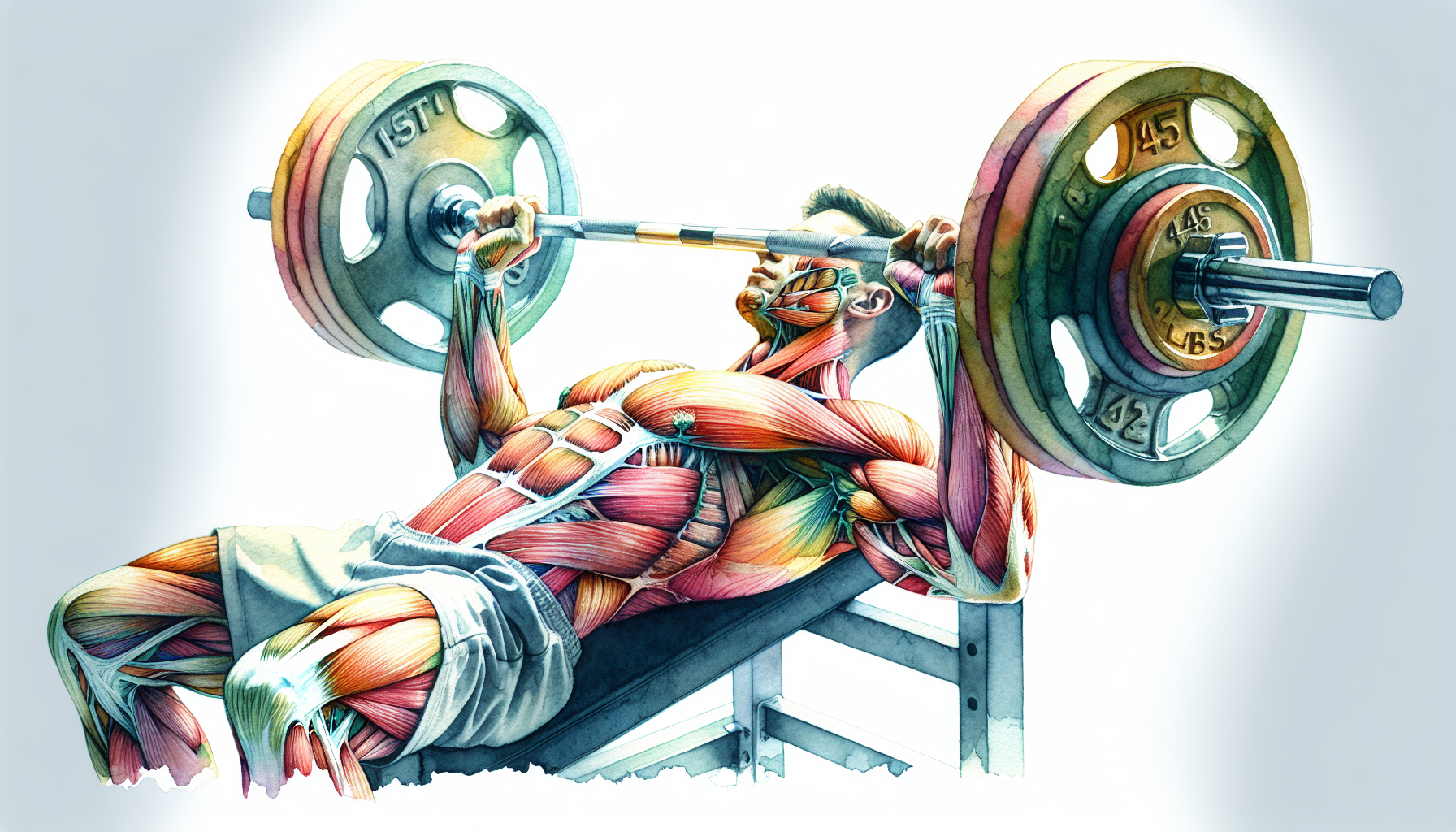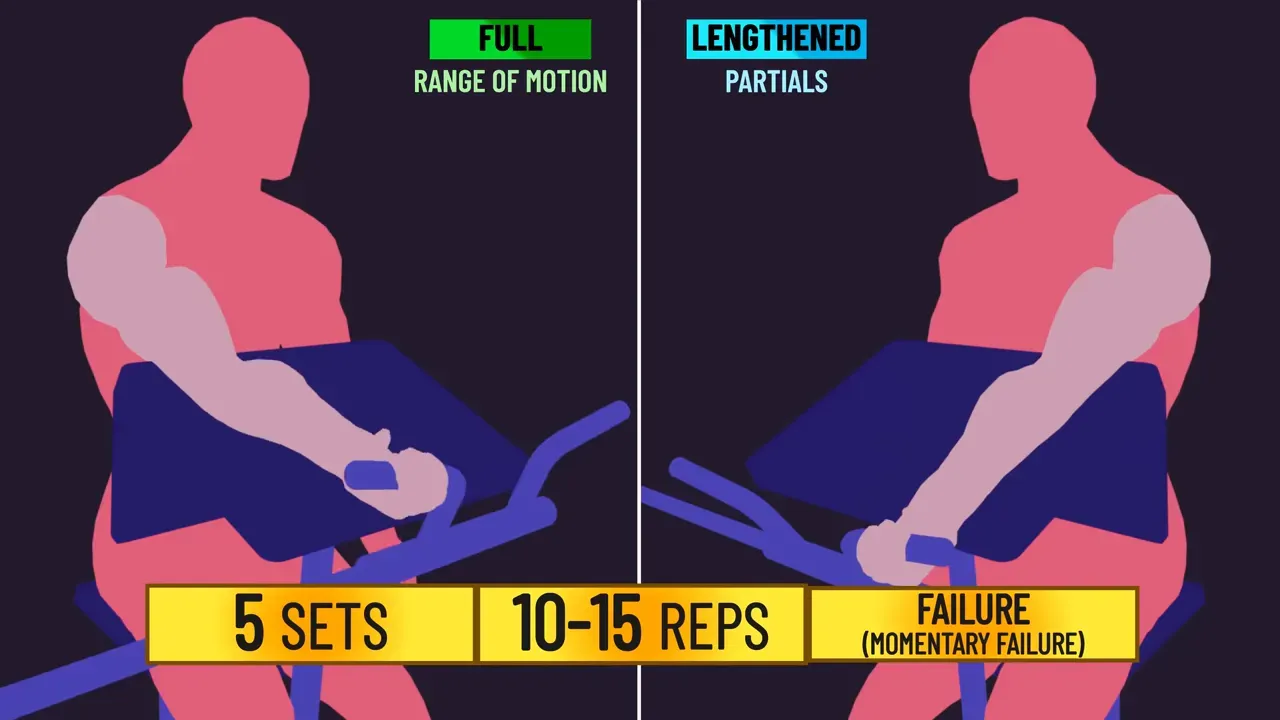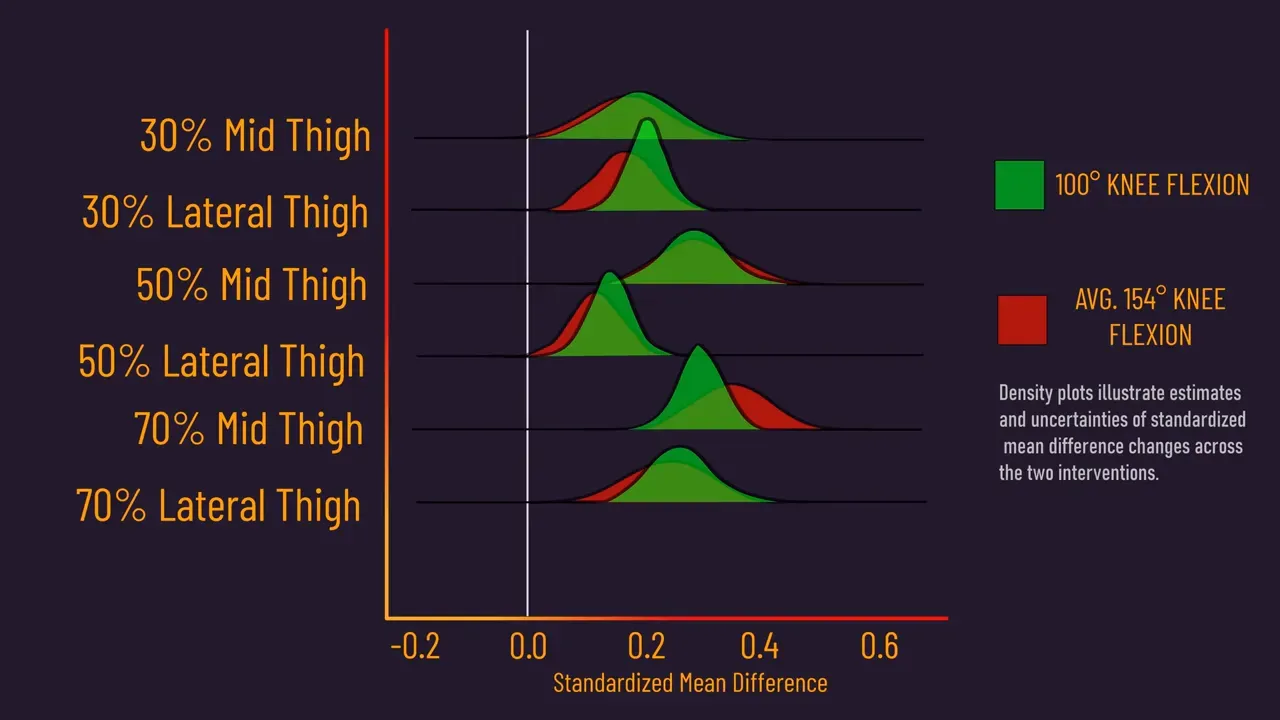Unlock Your Best Arms: Full ROM and Partials for Maximum Gains
Expert Guide to Science-Backed Range-of-Motion Strategies to Boost Muscle, Improve Weak Points, and Build an Impressive Physique Faster.

Key Takeaways
- You can use lengthened partials to target distal muscle regions more effectively.
- Your overall size is similar with full ROM or lengthened partials in trained lifters.
- You should avoid long-term reliance on shortened partials for best overall hypertrophy.
Try This Today
✔ Do unilateral preacher curls. Do 5 sets of 10–15 reps twice weekly. Use full ROM on one arm and a lengthened partial (0–70°) on the other for 8 weeks to compare results.
Want to build bigger arms with smarter range-of-motion choices?
In this expert review, we analyze, critique, and expand on House of Hypertrophy's latest breakdown of a new study comparing full range of motion and lengthened partials for biceps growth.
What makes this review different?
- Carefully reviewed and fact-checked by experts
- Little-known tips to use ROM variations to target specific muscle regions
- Complete workout plan inspired by using lengthened partials to emphasize distal growth
Why should you listen to us? Our articles are reviewed by exercise scientists with PhDs from top universities and 60+ years of combined training experience. We combine serious academic credentials with decades of practical training experience to give you science-backed advice you can trust. We've published 300+ articles so far.
Keep reading to learn what the data actually says, how to use it in the gym, and a practical, ready-to-run program that blends full ROM and partials so you get more muscle, less fat, and a better physique.
Related:
In A Nutshell: Range Of Motion And Hypertrophy
You can get similar overall hypertrophy with full range of motion (ROM) and lengthened partials in trained lifters. The new study showed similar mid-arm growth but hinted that lengthened partials produced slightly larger growth at the distal (near the elbow) region. You can use this to fine-tune your arm training and prioritize specific parts of the biceps if you want.
Your gains are still driven mainly by progressive overload, volume, and nutrition. ROM choice is a lever. It can nudge outcomes. It rarely overturns a well-run program.
Try a blend. Use full ROM most of the time. Add lengthened partials on select sets or exercises to bias distal hypertrophy.
Key Concepts
- Lengthened Partial: Work done with the muscle at longer lengths (e.g., early concentric range).
- Shortened Partial: Work done with the muscle at shorter lengths (e.g., end of concentric range).
- Regional Hypertrophy: Muscle growth can vary along a muscle's length. ROM can bias where growth happens.
Lengthened Partials Vs Full Range
Overview Of The New Study
Thirteen trained lifters took part. They had about six years of training experience on average. Each subject trained unilateral machine preacher curls twice a week for eight weeks.
One arm used full ROM. The elbow moved from 0° (extended) to 140° (flexed). The other arm did lengthened partials. That meant moving the elbow from 0° to 70° of flexion. In practical terms, the lengthened partial used the first half of the concentric phase. That keeps the biceps at longer lengths during each rep.

Training Protocol
Each arm completed five sets of 10–15 reps to momentary failure. Rest was two minutes between sets. Loads were adjusted so lifters hit failure in the prescribed rep range each session. Muscle thickness was measured at two points: 50% and 70% along the upper arm length. These capture a mid- and distal region.
Main Results
At the 50% (mid) region, growth was virtually the same between full ROM and lengthened partials. At the 70% (distal) region, growth tended to be larger for the lengthened partial condition.
The Bayesian evidence for a distal advantage with lengthened partials was modest (Bayes factor ~4.87). That means moderate evidence—not slam-dunk proof, but not nothing either.
What This Means
Lengthened partials seem to bias growth toward distal muscle regions. But they do not necessarily produce more overall muscle size in trained lifters. At least in this study, mid-arm size rose similarly with both ROM styles, and the distal advantage was small to moderate.
Limitations To Keep In Mind
- Small sample size (n=13). That limits statistical power.
- Single exercise (machine preacher curl). Results might differ with free weights or other curl variations.
- Short study length (8 weeks). Longer studies can reveal different trends.
- Measurements at only two arm sites. Other regions may behave differently.
Practical Takeaway
You can use lengthened partials as a tool to emphasize distal biceps growth. But do not think this one lever will make or break your overall arm development. Mix ROM approaches based on your goals and preferences.
Shortened Partials & Practical Implications
Where Shortened Partials Fit
Shortened partials work the final part of the concentric range. They load muscles at shorter lengths. Most early ROM debates painted shortened partials as inferior. That view was based on them often producing less overall hypertrophy versus full ROM.
What The Literature Shows
There are about ten studies comparing shortened partials with full ROM or lengthened partials. In general, shortened partials produce less overall hypertrophy on average. But they still stimulate growth. Sometimes they produce similar growth at mid-muscle regions. The conclusion: shortened partials aren't useless. They are just less reliable for maximal whole-muscle growth.
Can You Rescue Shortened Partials?
Yes. Extending the partial range helps. For example, squats to 60° knee flexion produced less growth than squats to 120° in one paper. But squats to 90° produced similar quad growth to squats to 140° in another study. So doing a slightly longer partial—say 90° vs 60°—can close the gap.

Where Shortened Partials Can Be Useful
- When you need to reduce joint stress while keeping tension on the muscle.
- To overload a specific sticking point or lockout strength.
- As a toolset for intensity techniques—e.g., after full ROM failure to squeeze extra reps near the top.
Practical Takeaway
Use shortened partials sparingly. Favor full ROM and lengthened partials most of the time for best hypertrophy. But keep shortened partials as a tool for specific needs like joint pain management, targeted overload, or advanced techniques.
Workout Plan Based On Lengthened Partials
This program blends full ROM and lengthened partials. It uses the main insight: lengthened partials can bias distal growth but full ROM is effective for the whole muscle. The plan is simple. You can run it for 8–12 weeks.
Program Overview
- Ideal for: trained lifters who want targeted arm growth and balanced overall development.
- Equipment needed: preacher curl machine or incline curl bench, dumbbells, barbell, cable machine, chin-up bar.
- Structure: 3 upper/lower split days. Two focused arm sessions per week integrated into upper body days.
Workout
Use moderate tempo. Control the eccentric. Aim for RPE 8–9 on work sets. Increase load or reps each week to maintain progressive overload.
Day A — Upper (Arm Focus)
- Barbell Bench Press — 4 sets × 6–8 reps — Rest 2–3 min
- Pendlay Row — 4 sets × 6–8 reps — Rest 2–3 min
- Preacher Machine Curl (Full ROM) — 4 sets × 8–12 reps — Rest 90–120 sec
- Incline Dumbbell Curl — 3 sets × 10–15 reps — Rest 60–90 sec
- Triceps Rope Pushdown — 4 sets × 10–15 reps — Rest 60–90 sec
Pro tips:
- Use full ROM on the preacher curl to hit mid-belly growth.
- Pause briefly at the bottom of each rep to increase time under tension.
- Keep elbows steady during incline curls to avoid shoulder involvement.
Day B — Lower
- Back Squat — 4 sets × 6–8 reps — Rest 2–3 min
- Romanian Deadlift — 4 sets × 6–10 reps — Rest 2 min
- Leg Press (deep) — 3 sets × 10–15 reps — Rest 90–120 sec
- Standing Calf Raise — 4 sets × 10–15 reps — Rest 60–90 sec
Pro tips:
- Use deep leg press to maximize quad and glute recruitment.
- Keep tempo controlled to prioritize muscle tension over momentum.
Day C — Upper (Lengthened Partial Focus)
- Weighted Chin-Ups — 4 sets × 6–10 reps — Rest 2–3 min
- Seated Cable Row — 4 sets × 8–12 reps — Rest 90–120 sec
- Preacher Machine Curl (Lengthened Partials: 0–70°) — 5 sets × 10–15 reps — Rest 90–120 sec
- Cable Hammer Curl (rope attachment) — 3 sets × 10–15 reps — Rest 60–90 sec
- Overhead Triceps Extension — 3 sets × 10–15 reps — Rest 60–90 sec
Pro tips:
- Do the lengthened partial preacher curls on the working arm after a heavier pull movement. This places a bias on distal biceps fatigue.
- Control the negative. Partial ROM can let you handle heavier loads, so avoid letting the weight slam back down.
Notes On Program Execution
- Train each muscle at least twice per week for optimal hypertrophy.
- Track load and reps. Aim to increase volume or load weekly.
- Deload every 4–8 weeks depending on fatigue and progress.
Want to automate workouts like that and more? Put your progress on autopilot with Dr. Muscle AI. Try Dr. Muscle AI—it's free
Expert Corner: Proven Strategies & Hidden Gems
Practical Applications
- Use One-Arm Experiments: Test full ROM vs lengthened partials on opposite arms for 6–8 weeks to see individual responses. Measure with circumference or photos.
- Region-Specific Emphasis: If your distal biceps lag, insert 3–5 sets per week of lengthened partial preacher curls. Keep reps 10–15 and stop 1–2 reps shy of failure if using high frequency.
- Post-Failure Partials: After a set to failure with full ROM, do 1–2 sets of lengthened partials to squeeze extra tension early in the concentric phase.
Examples:
- Example 1: On Upper Day C, add 5 sets of lengthened partials (0–70°) for 10–15 reps to bias distal growth.
- Example 2: If your short-head (outer sweep) looks good but the long head near the elbow is flat, prioritize incline curls and lengthened partial preacher curls for 8 weeks.
Fact-Check Of Key Points
- "Full range of motion moves the joints through their full potential." — True. Full ROM generally increases work at both short and long muscle lengths, which supports broad hypertrophy across the muscle.
- "Lengthened partials move the muscle at longer lengths." — True. If you restrict motion to the early concentric, the muscle spends more time at longer lengths where passive tension and stretch-mediated stimuli are greater.
- "Shortened partials are generally a bit worse for overall growth." — Partly true. The literature indicates slightly lower overall hypertrophy in many studies. But shortened partials still produce growth and can match full ROM at some mid-regions.
- "Lengthened partials might build more distal muscle." — Supported by recent data. Several studies show a distal advantage for lengthened partials in untrained lifters, and newer data suggests a similar trend in trained lifters.
More Little-Known Tips For Range Of Motion
- Tempo Matters: Slow eccentrics at long muscle lengths amplify tension and may favor sarcomere addition in series.
- Crossover Effects: Compound lifts will still expose muscles to long lengths. For example, weighted chin-ups load the biceps long and short—mix exercises thoughtfully.
- Fatigue Sequencing: Place lengthened partials after multi-joint lifts to avoid limiting heavy compound performance.
Common Mistakes With ROM & How To Fix Them
- Mistake: Assuming partials will save a failing program. Fix: Use partials as a complement, not a replacement. Track volume and progression.
- Mistake: Making partials too short (e.g., tiny 10° motions). Fix: Extend partials to meaningful ranges (e.g., 0–70° vs 0–140°) to preserve tension.
- Mistake: Overusing shortened partials when you want overall growth. Fix: Favor full ROM or lengthened partials for most training and save shortened partials for targeted use.
Science of Range of Motion and Muscle Hypertrophy
Resistance training range of motion (ROM) plays a meaningful role in muscle growth, but the optimal approach—whether full or partial ROM—is not universally superior. Recent systematic reviews and meta-analyses suggest that both full and partial ROM can stimulate hypertrophy, with specific advantages depending on the muscle group, joint angle, and training context.
Key Findings from Systematic Reviews and Meta-Analyses
- Full ROM generally produces slightly greater hypertrophy overall. A 2023 meta-analysis found trivial to small benefits for full ROM over partial ROM across outcomes like strength and muscle size, with standardized mean differences (SMDs) favoring full ROM between 0.05 to 0.2 (Wolf et al., 2023).
- Partial ROM at long muscle lengths can be as effective—or sometimes better—than full ROM. Reviews show that partial ROM exercises performed in the stretched (initial) position may elicit equal or even superior hypertrophy compared to full ROM, especially for muscles like the quadriceps and biceps (Kassiano et al., 2023), (Moreno et al., 2024).
- Muscle-specific responses and regional hypertrophy matter. Some muscles show different growth patterns depending on the ROM used, highlighting that full ROM may benefit certain muscle regions while partial ROM may enhance others (Newmire & Willoughby, 2018), (Schoenfeld & Grgic, 2020).
- Long muscle length training appears crucial. Reviews consistently point out that hypertrophy is enhanced when exercises stretch the muscle, either through full ROM or partial ROM targeting stretched positions (Ottinger et al., 2022).
Practical Applications of Science
- Include a combination of full ROM and partial ROM at long muscle lengths in your training program.
- For hypertrophy in specific muscle regions (e.g., distal biceps), use ROMs that stretch those muscle areas under load.
- Avoid relying solely on partial ROM in shortened positions, as this tends to produce less hypertrophy.
Scientific Conclusion
Both full and partial range of motion can build muscle effectively, but training muscles in stretched positions—whether through full ROM or strategic partial ROM—is key to maximizing hypertrophy.
My Opinion On Range Of Motion For Size
I believe ROM is a practical tool you can use to polish your physique. I favor full ROM as the default. It reliably produces broad, even hypertrophy. I also like lengthened partials for targeted work. They can recruit stretch-mediated growth pathways and bias distal hypertrophy.
I disagree with the idea that partials are either magic or junk. They are a variation. They give you a different stimulus. Use them intelligently. Pair partials with solid volume and progressive overload.
I think the new study adds useful nuance. It shows trained lifters can still get benefits from manipulating ROM. The distal advantage with lengthened partials is real enough to experiment with, but small enough that you should not ditch full ROM altogether.
I would be a bit controversial on one point: some lifters obsess over exact joint angles and forget the basics. If you chase ROM minutiae and miss progressive overload, your progress will stall. Use ROM to refine, not replace, your core plan.
Concluding On Range Of Motion Choices
Range of motion matters. But it is one lever among many. Full ROM gives you a safe, broad stimulus. Lengthened partials bias the distal portion of a muscle and can be a smart addition if you have a specific weak point. Shortened partials still work. But they often lag as a primary strategy for whole-muscle hypertrophy.
Use a mix. Program full ROM for the bulk of your work. Add targeted lengthened partials once or twice a week for problem spots. Reserve shortened partials for special purposes like joint pain management or technique work.
If you want to automate these choices and keep progressive overload on autopilot, try Dr. Muscle AI. It builds balanced plans, adjusts volume, and keeps your workouts aligned with your goals. Try Dr. Muscle AI—it's free
FAQ
Is Full Range Of Motion Better For Muscle Growth?
Full range of motion is not universally superior, but it reliably produces broad hypertrophy across a muscle. In many studies, full ROM and lengthened partials produce similar overall gains, especially in trained lifters.
What Are Lengthened Partials?
Lengthened partials are repetitions performed through the portion of a movement where the target muscle is at longer lengths—usually the early concentric phase. They can bias growth toward distal muscle regions and increase tension at long muscle lengths.
Should You Train With Partials If You're Experienced?
Yes. Experienced lifters can benefit from partials to target weak regions or extend sets. Use lengthened partials to bias distal hypertrophy and mix them with full ROM for balanced size gains.
Do Shortened Partials Build Muscle?
Shortened partials do build muscle but tend to produce slightly less overall hypertrophy than full ROM or lengthened partials. They can still be useful for specific goals or to reduce joint stress when needed.
How Many Sets Of Lengthened Partials Should You Do?
Start with 3–5 sets per week of lengthened partials for the target muscle, with 10–15 reps per set. Adjust based on recovery and observed gains after 6–8 weeks.
Will Partials Make Your Muscles Look Weird?
No. Small regional differences in hypertrophy rarely produce odd-looking muscles. Balanced programming that mixes ROM types prevents extreme imbalances and leads to a natural, full look.
How Long Should You Run A ROM Experiment?
Run a ROM comparison for at least 6–8 weeks. This timeframe lets you notice real changes while keeping the test manageable. Measure progress with photos, measurements, or ultrasound if available.
Can ROM Replace Progressive Overload?
No. ROM is a tool, not a substitute. Progressive overload—adding load or volume over time—is still the primary driver of hypertrophy. Use ROM changes to complement overload strategies.
Which Exercises Are Best For Lengthened Partials?
Isolation movements like preacher curls or leg extensions are easy to perform as lengthened partials. Machines help control motion, but you can also use cables or free weights if you can limit joint angles safely.
Is There A Risk Of Injury With Partials?
Any training choice has risk. Long, controlled reps at long muscle lengths increase passive stress, so progress gradually. Keep technique tight and avoid sudden heavy loads if you are unaccustomed to the ROM.
Final Note
Range of motion is a high-value, low-complexity tool. Use it to fine-tune your physique. Mix full ROM and lengthened partials to get the best of both worlds. Automate your progression and volume with Dr. Muscle AI for a consistent, evidence-based approach. Try Dr. Muscle AI—it's free
We used AI to summarize the video The BEST Range of Motion for Size (New Study) while drafting this expert review.

